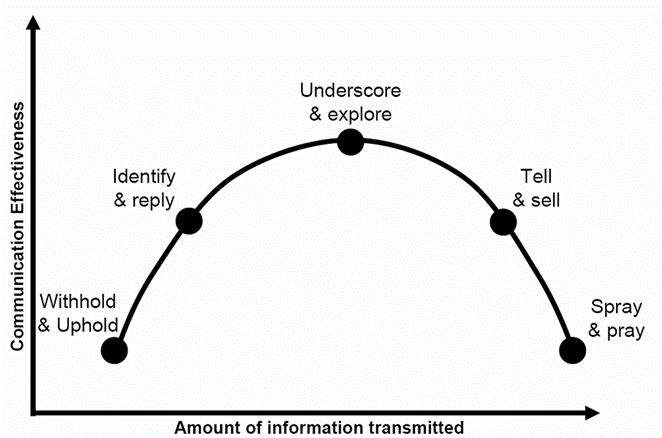Often times I hear program managers who say: we need to communicate, communicate, communicate! In their view, successful communication comes down to transmitting a high volume of information in a high frequency.
However – in my humble opinion – communication is not the message sent, but the message received. So I tend to measure the success of a communication at the receiver’s end. That is: the final destination. The message here is: ‘more is not always better’. A few years ago I came along a chart which explains my point very well.
Style in communications has very much to do with the openness of information (expressed in the quantity of information that is provided). The relationship to the effective use of the communications is shown below.

The chart is read as follows:
- Withhold and uphold: Knowledge is power. We only release information when we are forced to do so. Giving little information results in reduced effectiveness (meaning: confusion and disorientation).
- Identify and reply: Providing information at a personal level; addressing each staff member within his/her personal frame of reference is more effective, but not always optimal. Advantage: two-directional traffic. Disadvantage: you have not created a general frame of reference, which leaves the door open for many deviations and exceptions. Such a communications policy is adjusted on an individual basis. This is time-consuming and not very effective.
- Underscore and explore: This style is optimal, because here you allow two-directional traffic within a specific frame of reference. You first mark out the terrain (you create the frame of reference), and only then do you resume communicating. Because you have started by staking out the playing field, it immediately becomes clear what is given a chance and what is not. The communication that takes place thereafter is limited to this marked out playing field. This saves time and all noses will point in the same direction.
- Tell and sell: More information is passing more frequently through the organization, yet its effectiveness is declining. Even though there is a well-cared-for presentation and layout, no room remains for interaction. No adjustments will be made, because feedback is lacking, and all the messages will sound the same and have a deadening effect. Paralyzing jams in communications traffic will be the result, and the attention will focus on bypass channels of communication.
- Spray and pray: A paragon of openness; “I share all information with my colleagues; I am an open book”. What a shame, because too much information has the same effect as too little: confusion and disorientation. This chart teaches us that good communications are truly an exercise of balance, which can only be learned by making errors and adapting.
I’m afraid that the program managers who are keen on high volumes of information transmission have a different view on the shape of this curve. Theirs is going from the below left-hand corner to the upper right. The sky is the limit… and in the end nobody is listening anymore: the perfect alibi to claim that people are stupid.
NOT!
____________
Source: De Koch & Cashman, A strategy for communicating about uncertainty, The Academy of Management Executive,November 01, 2000


Pingback: What on Earth are we Communicating for? | Reply-MC()